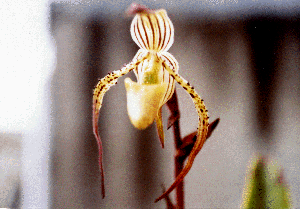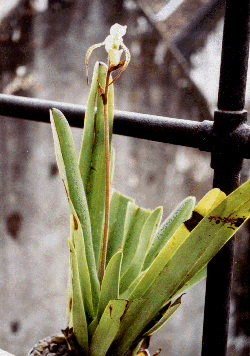Please cooperate with rejecting the illegal Paphs.
The newly discovered Paphiopedilum
NO. 22 Paphiopedilum intaniae
This new species was described by Dr. William Cavestro in RHONE-ALPES ORCHIDEES (French Orchid Review), N。25, pp. 2-8, January-August 2000. Offprint : 15 April 2000.
This information was supplied by Dr. William Cavestro. Thank you Dr. Cavestro.
A new species of Paphiopedilum is described : P. intaniae W. Cavestro. This paper focuses on the description and identification of P. intaniae, a new species discovered on February 7 th 2000 in the limestone hills and cliffs near to Gunung Morowali Mont, in the eastern center of the Island of Sulawesi, Indonesia. This species is closed to P. philippinense (Rchb.f.) Stein, P. randsii Fowlie and P. stonei (Hook.) Stein. However P. intaniae is morphologically distinct in several features from those of P. stonei, the closest species. P. intaniae has shorter and straight petals (not twisted),
maculated with brown from the base to half the length then striated and flushed with brown in the apical half. It has also 4 to 6 small ciliated warts on the each side near to the base towards the middle of the length of the petals. This feature is not observed on the petals of P. stonei. The lip of P. intaniae is shorter than the lip of P. stonei. The staminode is different : convex, subcircular, truncate for P. stonei ; narrow at base, then enlarged and bilobed at apex for P. intaniae. Pedicel and ovary are also different : glabrous for P. stonei, hairy for P. intaniae. The differences between this species and P. stonei, P. philippinense and P. randsii are strong arguments to consider P. intaniae as a new species in the genus Paphiopedilum.Diagnose : Paphiopedilum intaniae W. Cavestro, sp. nov.
Paph. intaniae
Photo by
Mr. Ayub. S. Parnata.
Paph. intaniae
Photo by
Mr. Ayub. S. Parnata.
Detailed Description :
Terrestrial herbaceous and erected plant. 4-7 green, coriaceous, lineare
leaves, obtuses at apex, 25-40 cm long and 4,5-6 cm large. Inflorescence
erected, covered with brown hairs, 35-50 cm long. 3 to 8 flowers, 10 cm to
12 cm across. Large bracts covered with brown hairs, 2,3-2,5 cm long and
0,8-1 cm large. Ovary brown, densely covered with hairs, 2,5 cm long and 0,6
cm large. Pedicel arcuate, brown and pilose, 1,1 cm long. Dorsal sepal and
synsepal white and greenish white at base, striated with brown ; petals
white or greenish white maculated with brown from the base to half the
lenght then striated and flushed with brown in apical half ; lip pale yellow
reticulated with pale brown. Staminode light green or pale yellow,
reticulated with green in the center, white on each side.
Dorsal sepal lanceolate, obtuse at base, acuminate, ciliate, 4,4-4,8 cm long
and 1,6-1,9 cm large. Synsepal ovate-lanceolate, slightly concave,
acuminate, ciliate at apex, 4-4,2 cm long and 1,4-1,5 cm large. Petals
narrow, lineare, arcuate, not twisted, 6,5-7 cm long and 0,4-0,5 cm large ;
4-6 small, 1 mm large, ciliate warts from the base to the middle of the
lenght. Lip small, ovoid, 3-3,5 cm long and 1,6-1,8 cm large. Staminode
convex, narrow and ciliate at base, emarginate, reticulate in the middle,
0,8-0,9 cm long and 0,5-0,6 cm large at apex ; 2 lobes at apex separated by
a small notch 1 mm deep ; small induration at base.
The figure of Paph. intaniae.
Back to the index of the newly discovered Paph.
Back to Dr. Tanaka's Home page Index

